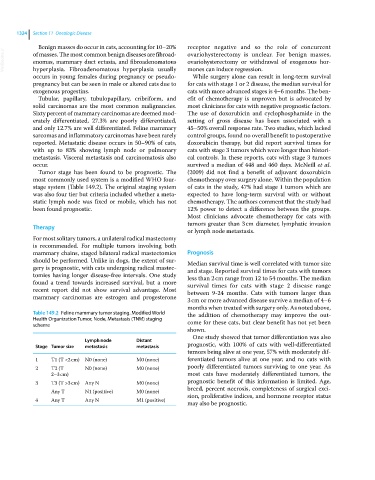Page 1386 - Clinical Small Animal Internal Medicine
P. 1386
1324 Section 11 Oncologic Disease
Benign masses do occur in cats, accounting for 10–20% receptor negative and so the role of concurrent
VetBooks.ir of masses. The most common benign diseases are fibroad- ovariohysterectomy is unclear. For benign masses,
ovariohysterectomy or withdrawal of exogenous hor-
enomas, mammary duct ectasia, and fibroadenomatous
hyperplasia. Fibroadenomatous hyperplasia usually
While surgery alone can result in long‐term survival
occurs in young females during pregnancy or pseudo- mones can induce regression.
pregnancy but can be seen in male or altered cats due to for cats with stage 1 or 2 disease, the median survival for
exogenous progestins. cats with more advanced stages is 4–6 months. The ben-
Tubular, papillary, tubulopapillary, cribriform, and efit of chemotherapy is unproven but is advocated by
solid carcinomas are the most common malignancies. most clinicians for cats with negative prognostic factors.
Sixty percent of mammary carcinomas are deemed mod- The use of doxorubicin and cyclophosphamide in the
erately differentiated, 27.3% are poorly differentiated, setting of gross disease has been associated with a
and only 12.7% are well differentiated. Feline mammary 45–50% overall response rate. Two studies, which lacked
sarcomas and inflammatory carcinomas have been rarely control groups, found no overall benefit to postoperative
reported. Metastatic disease occurs in 50–90% of cats, doxorubicin therapy, but did report survival times for
with up to 83% showing lymph node or pulmonary cats with stage 3 tumors which were longer than histori-
metastasis. Visceral metastasis and carcinomatosis also cal controls. In these reports, cats with stage 3 tumors
occur. survived a median of 448 and 460 days. McNeill et al.
Tumor stage has been found to be prognostic. The (2009) did not find a benefit of adjuvant doxorubicin
most commonly used system is a modified WHO four‐ chemotherapy over surgery alone. Within the population
stage system (Table 149.2). The original staging system of cats in the study, 47% had stage 1 tumors which are
was also four tier but criteria included whether a meta- expected to have long‐term survival with or without
static lymph node was fixed or mobile, which has not chemotherapy. The authors comment that the study had
been found prognostic. 12% power to detect a difference between the groups.
Most clinicians advocate chemotherapy for cats with
tumors greater than 3 cm diameter, lymphatic invasion
Therapy
or lymph node metastasis.
For most solitary tumors, a unilateral radical mastectomy
is recommended. For multiple tumors involving both
mammary chains, staged bilateral radical mastectomies Prognosis
should be performed. Unlike in dogs, the extent of sur- Median survival time is well correlated with tumor size
gery is prognostic, with cats undergoing radical mastec- and stage. Reported survival times for cats with tumors
tomies having longer disease‐free intervals. One study less than 2 cm range from 12 to 54 months. The median
found a trend towards increased survival, but a more survival times for cats with stage 2 disease range
recent report did not show survival advantage. Most between 9‐24 months. Cats with tumors larger than
mammary carcinomas are estrogen and progesterone 3 cm or more advanced disease survive a median of 4–6
months when treated with surgery only. As noted above,
Table 149.2 Feline mammary tumor staging. Modified World the addition of chemotherapy may improve the out-
Health Organization Tumor, Node, Metastasis (TNM) staging come for these cats, but clear benefit has not yet been
scheme
shown.
One study showed that tumor differentiation was also
Lymph node Distant
Stage Tumor size metastasis metastasis prognostic, with 100% of cats with well‐differentiated
tumors being alive at one year, 57% with moderately dif-
1 T1 (T <2 cm) N0 (none) M0 (none) ferentiated tumors alive at one year, and no cats with
2 T2 (T N0 (none) M0 (none) poorly differentiated tumors surviving to one year. As
2–3 cm) most cats have moderately differentiated tumors, the
3 T3 (T >3 cm) Any N M0 (none) prognostic benefit of this information is limited. Age,
Any T N1 (positive) M0 (none) breed, percent necrosis, completeness of surgical exci-
4 Any T Any N M1 (positive) sion, proliferative indices, and hormone receptor status
may also be prognostic.

